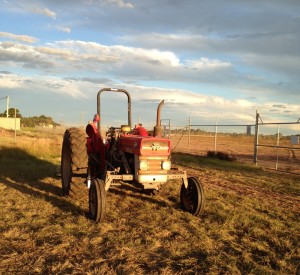Agricultural land in and around the Sydney Basin provide many important environmental services such as cooling our urban areas, pest-control and providing corridors for wildlife. If managed well, agriculture is a good buffer between protected areas and urban development.

Environmental benefits of local food
Local food systems, with their short distance to market and limited storage time, are likely to have a smaller impact on the environment: less food waste, less food miles due to fewer carbon emissions being used to move the food between paddock and plate, less water consumed as well as fewer chemical enhancements being required to ensure that food does not spoil in transit.
Local food systems in cities have other environmental benefits, such as ecosystem services, food waste reduction and the potential to absorb and reutilise many of the waste resources generated by cities – such as Phosphorus.
Over 50 per cent of NSW vegetables are grown in the Murray-Darling and Murrumbidgee regions where water availability is becoming a significant problem, particularly as our climate changes. Sydney has good quality agricultural land and may also have more reliable rainfall than inland areas as climate change occurs. The capacity for Sydney to continue to provide locally-grown vegetables should be not just maintained, but increased, if Sydney is to be food secure.
Ecosystem services
Peri-urban agriculture provides ecological benefits that are known as ‘ecosystem services’ – the types of values that we enjoy from having green space and biodiversity. These might include improved water and waste management, reduced urban heat effects and improved air quality, reduced carbon emissions, conservation of biodiversity, and improved nutrient recycling.
By its very nature, well-managed productive farmland discourages feral animals and weeds that might otherwise destroy native flora and fauna through competition and predation. In contrast, unproductive rural land ‘in waiting’ for urban development generally promotes exotic weeds and is a haven for feral animals and pests, posing a serious threat to biodiversity. Protecting agricultural lands can provide biodiversity and other benefits, including allowing for effective groundwater recharge and maintaining soil quality.
Cooling urban areas
Large acreage lots remain substantially (10 – 15°C) cooler than the residential areas on such days
As our climate changes and our cities become less liveable due to extreme weather and temperature increases, we will become more reliant on the ecosystem services that peri-urban agriculture is capable of providing. The ‘urban heat island effect’ is the name given to the phenomenon that sees our cities retaining and creating more heat than adjacent areas, due to their concentration of cars, buildings and surfaces that store heat, such as a concrete and bitumen. As our climate becomes increasingly extreme, the frequency of ‘very hot days’ that we experience will rise, and the importance of these cooler areas to ensuring that our cities are liveable will grow.
We know that the peri-urban areas that are adjacent to cities, which have a much lower density of buildings and roads and much more greenery such as grass, crops and tree coverage, are cooler than suburban and urban areas. Recently developed ‘heats maps’ show the stark difference between large acreage lots and moderate density residential lots on a mid-summer’s day: the large acreage lots remain substantially (10 – 15°C) cooler than the residential areas on such days. As the number of extreme heat days increases under a changing climate, we will see the importance of the cooling effect of peri-urban areas growing.